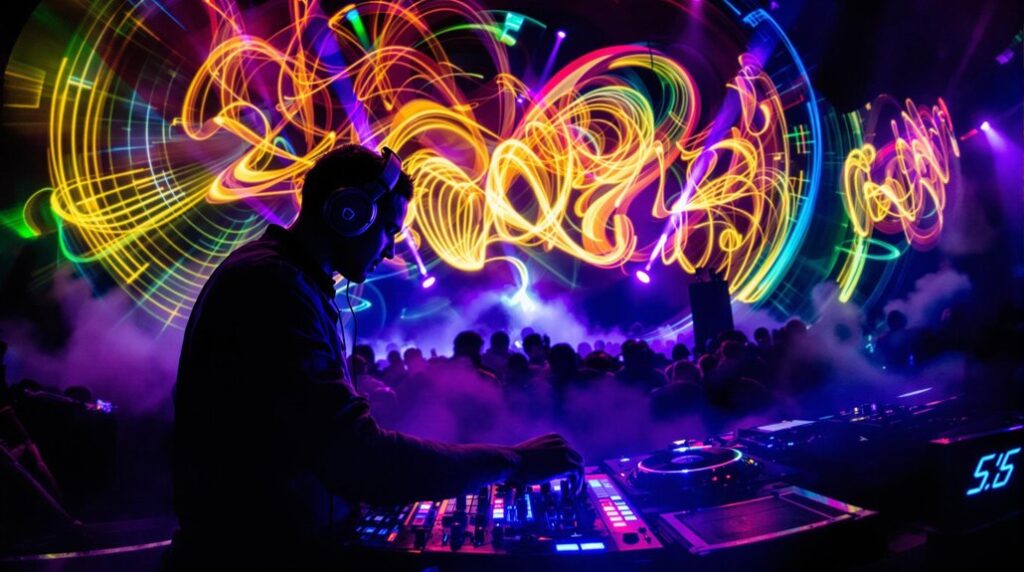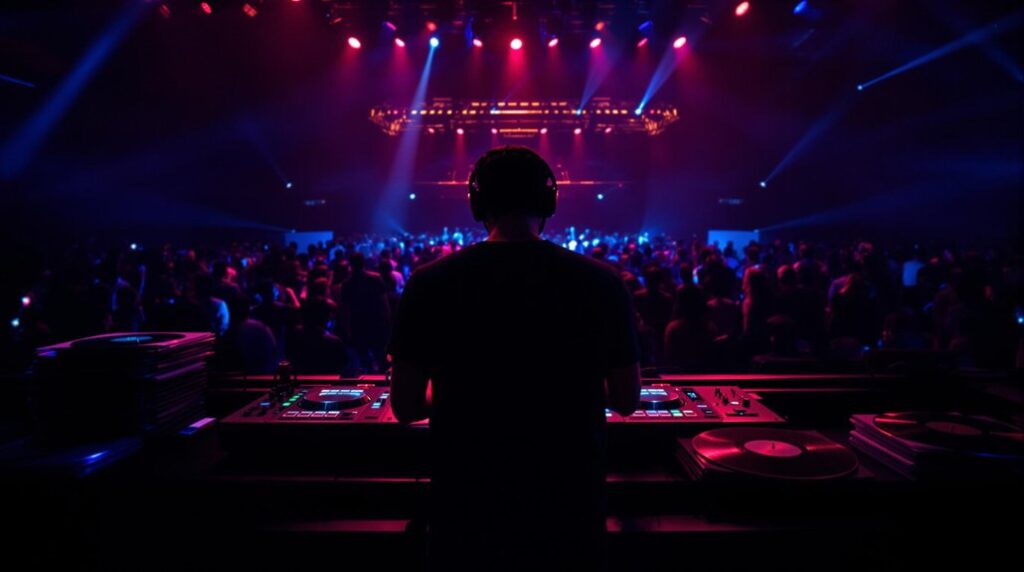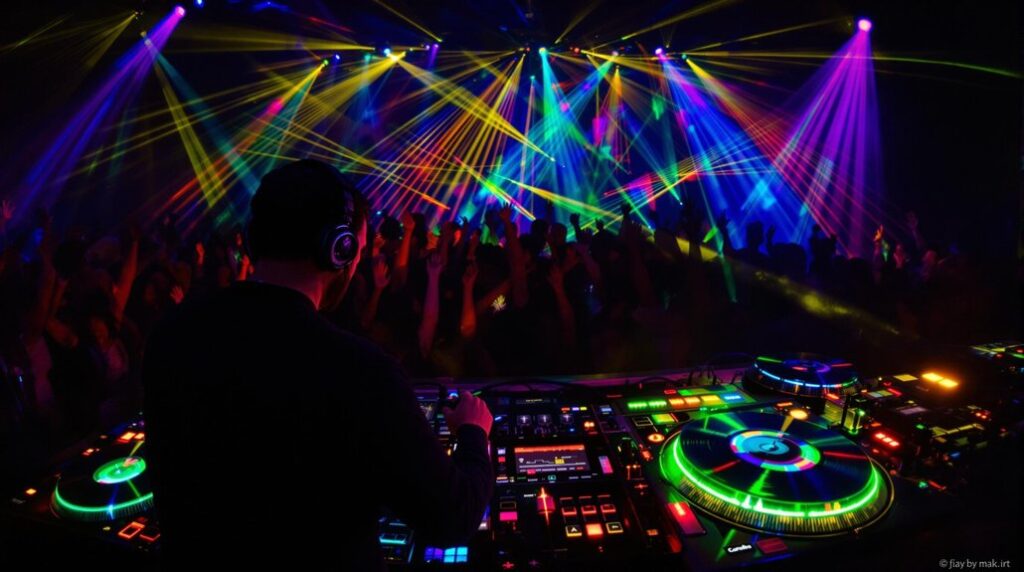Choosing the right DJ mixer hinges on understanding their intricate features and various types. Crucial aspects include channels, EQ controls, crossfader quality, and headphone monitoring. Beginners may opt for basic mixers, while professionals might seek multi-channel or hybrid versions. Precise signal management and connectivity with digital setups are essential for creative performances. Maintaining equipment through cleaning and software updates guarantees longevity. Exploring further will reveal deeper insights into selecting the ultimate mixer tailored to one's style and needs.
Key Takeaways
- Select a two-channel mixer for beginners and a multi-channel mixer for more complex performances.
- Prioritize mixers with EQ controls, volume faders, and headphone monitoring for optimal mixing capabilities.
- Choose scratch mixers for durability and responsiveness; rotary mixers for enhanced sound quality in specific genres.
- Consider hybrid mixers for flexibility, accommodating both analog and digital audio sources.
- Look for mixers with built-in effects and drum sequencers to boost creative expression in DJing.
Understanding DJ Mixers
Understanding DJ mixers is essential for anyone aspiring to master the art of DJing, as these devices form the backbone of any DJ setup.
At the heart of DJ mixers are volume faders and crossfaders, which allow for precise audio level control and smooth shifts between tracks. EQ controls further refine the sound by adjusting bass, midrange, and treble frequencies, enabling professional DJs to craft their signature sound.
Modern mixers often feature integrated USB audio interfaces, facilitating seamless connectivity with digital equipment. Standalone mixers differ from DJ controllers; the former blends audio signals independently, while controllers rely on DJ software.
The inclusion of RCA inputs enhances compatibility, ensuring superior sound quality. Such features make DJ mixers indispensable in achieving audio excellence. Additionally, DJ software like Serato DJ Lite can be integrated with mixers, providing beginner DJs with an intuitive interface and powerful tools for their performances.
Types of DJ Mixers
For those exploring the intricate world of DJ mixers, recognizing the different types available is a fundamental step toward refining one's craft. Basic DJ mixers, with their two-channel design, offer newcomers the functionality and ease needed to manage two audio sources, making them perfect for simple performances. Multi-channel mixers enhance capabilities, accommodating numerous audio sources, accordingly thriving in professional environments that demand complexity. Scratch mixers cater to turntablists, emphasizing durability and rapid response for advanced scratching techniques. Rotary mixers, with their tactile rotary knobs, deliver superior sound quality, especially favored in house and techno genres. Hybrid mixers embody modern DJ technology, merging traditional mixer functions with digital controller elements, featuring built-in DSP effects for unmatched versatility in diverse performances. The integrated Sound Color FX in some DJ mixers provide unique sound manipulation options, enhancing creative performance capabilities for DJs.
Key Features to Look for in a Mixer
A DJ mixer is the heartbeat of any performance setup, and selecting the right one hinges on understanding both essential components and advanced technologies.
At the core, features such as the number of channels, EQ controls, and crossfader quality form the backbone of a functional mixer, catering to various skill levels and mixing styles.
Meanwhile, innovations like integrated USB audio interfaces and headphone monitoring capabilities redefine versatility and connectivity, making modern mixers indispensable tools for digital and traditional setups alike.
Additionally, superior build quality ensures reliability during intense performances, with high-quality components designed to withstand frequent use.
Essential Mixer Components
In the field of DJing, the mixer stands as a fundamental tool, bridging creativity and technical prowess.
A DJ mixer's essential components, such as volume faders, crossfader, and EQ controls, are significant for crafting seamless shifts and achieving precise beatmatching.
Smooth, responsive volume faders provide precision in audio level adjustments, while a reliable crossfader facilitates the swift switching between audio sources, allowing for dynamic mixing techniques.
EQ controls—typically three-band—offer DJs the ability to tweak bass, mid, and treble frequencies for a harmonious sound.
Multiple input options, including RCA, 6.35 jacks, and balanced XLR, enhance connectivity with diverse audio sources.
Additionally, headphone monitoring is indispensable, permitting DJs to cue tracks confidently before public play, ensuring a polished performance.
Advanced Mixer Technologies
When delving into the area of advanced mixer technologies, understanding the key features that enhance a DJ mixer from basic to exceptional becomes crucial.
Advanced features in the mixer section, such as multiple input channels, allow DJs to manage various audio sources, ensuring seamless changes and dynamic layering during performances.
EQ controls provide precise control over bass, midrange, and treble frequencies, tailoring sound to diverse music styles.
Integrated USB audio interfaces facilitate direct connections to computers, enhancing functionality with DJ software.
A high-quality crossfader, offering adjustable tension, is essential for smooth changes between tracks.
Monitor outputs deliver real-time feedback, enabling DJs to perfect their mix before it reaches the audience.
These elements collectively define a mixer's potential for professional-grade performance.
Comparing DJ Mixers and Controllers
As digital technology continues to reshape the DJ environment, understanding the distinct roles of DJ mixers and controllers becomes essential for both novices and veterans in the field. DJ mixers are standalone units focusing on audio sources and mixing functions, making them crucial in professional environments. They offer a hands-on approach, ideal for beginners mastering essential gear. In contrast, DJ controllers rely on software integration, providing dynamic performance capabilities through features like jog wheels and performance pads. Mixing functions such as EQ adjustments are crucial for achieving sound balance during sets.
| Feature | DJ Mixers | DJ Controllers |
|---|---|---|
| Audio Sources | Independent blending | Software-dependent |
| Mixing Functions | EQ adjustments, fader control | Integrated with digital features |
| Ideal Users | Beginners, professionals | Software-savvy users |
| Performance Capabilities | Focus on signal management | Enhanced with multi-effects processors |
Choosing between them depends on one's style and venue needs.
Choosing the Right Mixer for Your Style
Understanding the distinct roles of DJ mixers and controllers aids in making informed decisions, leading seamlessly into the art of choosing the right mixer for one's style. A DJ mixer with appropriate channels is vital; beginners may opt for two-channel models, while those desiring complexity might seek multi-channel versions. Essential features such as EQ controls, volume faders, and headphone monitoring guarantee smooth track shifts. Scratch mixers offer rapid response, ideal for DJs focused on intricate techniques. Rotary mixers, with their superior sound quality, appeal to house and techno enthusiasts. For those embracing versatility, hybrid mixers merge analog capabilities with digital controller elements, accommodating both analog and digital sources. Features like built-in effects and drum sequencers enhance creative expression and exploration in DJing. Consequently, selecting a mixer hinges on individual style and performance needs.
Maintenance and Care for DJ Mixers
In the world of DJing, the longevity and performance of a mixer hinge on meticulous maintenance and care. Regular cleaning routines are essential to prevent dust accumulation, while weekly cable inspections help avert unexpected audio issues during live sets. Staying attuned to software updates guarantees that the mixer not only operates efficiently but also benefits from the latest enhancements introduced by manufacturers. Implementing a dust prevention strategy post-cleaning is crucial for maintaining device condition and ensuring optimal performance over time.
Regular Cleaning Routines
Every DJ knows that maintaining pristine equipment is essential for seamless performances. Regular cleaning routines for a DJ mixer are vital to guarantee equipment longevity and peak performance. After each use, a soft, lint-free cloth should be employed to clean the mixer's external surfaces, preventing dust and sweat buildup.
Weekly inspections of cables are recommended to avoid audio issues, as damaged cables can compromise sound quality.
To further maintain the mixer:
- Use compressed air to clear dust from knobs and faders.
- Calibrate knobs and faders according to manufacturer guidelines.
- Regularly update mixer software for enhanced functionality.
- Keep the buttons and controls responsive with consistent cleaning.
- Schedule maintenance checks to prolong equipment lifespan.
These steps guarantee the DJ mixer remains reliable and efficient.
Cable Inspection Tips
Maintaining a DJ mixer in ideal condition involves more than just regular surface cleaning; attention must also be given to the cables that connect various components. Regular inspections for wear and tear, fraying, or damage are vital to prevent signal loss and guarantee peak performance.
Employing color-coded tape or labels aids in maintaining organization during setup and teardown, easing troubleshooting. To preserve cable quality, neatly coil them when not in use, minimizing insulation wear.
Opting for balanced XLR or TRS cables for master output connections minimizes noise interference, assuring high-quality audio. Establishing a weekly inspection routine allows for prompt attention to any issues, preserving the longevity and reliability of the equipment by confirming all connections are sound and efficient.
Software Update Schedule
How often do DJ enthusiasts pause to contemplate the significance of a well-timed software update?
For the dedicated DJ, maintaining the DJ mixer through regular software and firmware updates is essential. A monthly review schedule guarantees peak performance and compatibility with the latest DJ software.
Consider these vital tips:
- Regularly check for firmware updates to keep the equipment running smoothly.
- Read release notes to understand new features and potential bugs.
- Back up mixer settings to prevent data loss during updates.
- Confirm compatibility between DJ mixer updates and DJ software.
- Verify system requirements to ensure smooth operation post-update.
These strategies help avoid technical glitches, guaranteeing your DJ mixer remains a reliable partner in every performance.
Frequently Asked Questions
What Gear Do You Need to DJ?
To DJ effectively, one requires various DJ gear types: essential accessories like headphones and audio interfaces, software options for track management, sound systems, controller features for mixing, and performance techniques, all balanced within budget considerations and setup tips.
What's a Good DJ Mixer to Start With?
When evaluating beginner mixers, one must consider essential features, budget considerations, brand comparisons, and user reviews. Connectivity options, port types, portability factors, sound quality, and potential upgrade paths are vital in selecting an ideal starting DJ mixer.
What Is the Standard Equipment Setup for a DJ?
A standard DJ setup includes essential DJ gear like two decks and a mixer, enhanced by digital controllers and audio interfaces. Emphasizing sound quality and mixing techniques, DJs should explore software options, performance tips, and avoid beginner mistakes.
What Order Do You Turn on DJ Equipment?
The DJ setup order requires careful equipment power sequence: mixer activation steps first, followed by audio interface startup, then controller power timing and turntable initialization. Ascertain speaker connection sequence follows, considering headphone connection method and equipment troubleshooting tips throughout.
Conclusion
In the dynamic world of DJing, selecting the right mixer is pivotal to crafting seamless sets and enhancing performance. By understanding the different types of mixers and their key features, DJs can align their gear with their unique style. Comparing mixers with controllers offers further clarity, ensuring informed decisions. Ultimately, investing in proper maintenance preserves the equipment's longevity, allowing DJs to consistently deliver exceptional experiences. Mastering these essentials empowers DJs to uplift their artistry and captivate audiences.




